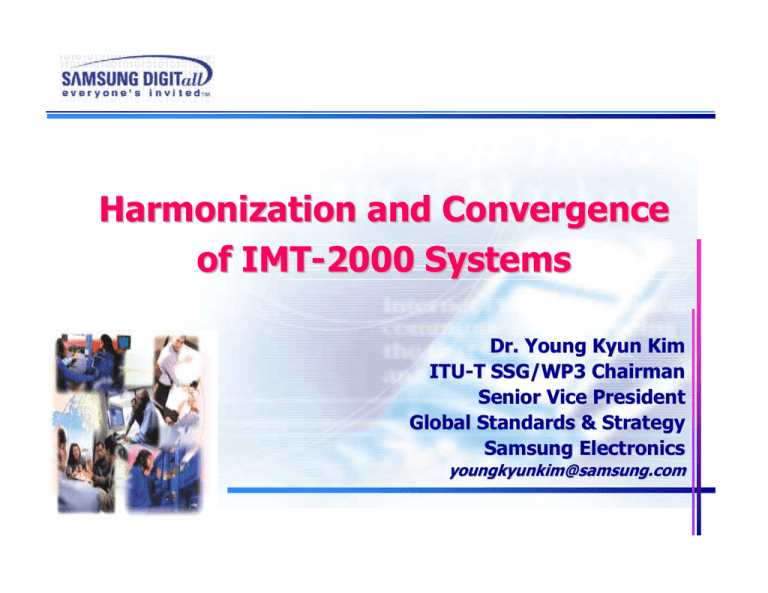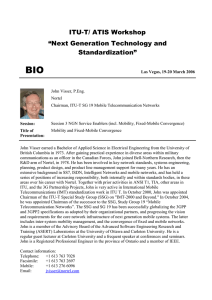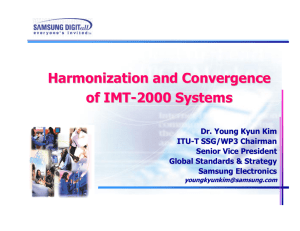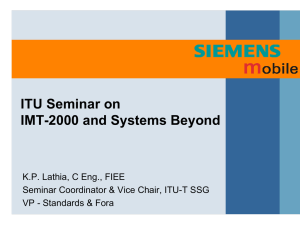Harmonization and Convergence of IMT - 2000 Systems
advertisement

Harmonization and Convergence of IMT-2000 Systems Dr. Young Kyun Kim ITU-T SSG/WP3 Chairman Senior Vice President Global Standards & Strategy Samsung Electronics youngkyunkim@samsung.com Outline Industry Trends Core Network Harmonization Benefits of Harmonization Recent IP CN Workshop in Toronto Role of ITU-T SSG on “IMT-2000 and Beyond” Studies in WP3/SSG Harmonization Fixed/Mobile Convergence Concluding Remarks 2 Industry Trends 3G systems are evolving to provide enhanced capabilities to meet end-user needs. 3G CNs are migrating towards a common packet-switched architecture using IETF protocols. Service providers are moving towards support for an IP-based multimedia service concept. Convergence of fixed and wireless networks provides additional synergy. 3 Harmonization Objective A harmonized CN solution can Foster global roaming across all evolving IMT2000 systems Facilitate cost-effective IMT-2000 network deployments based on the standardized open interfaces Stimulate the commercial uptake of IMT-2000 services Harmonized CN standard should give network operators ability to deploy new services without adverse impact on other common systems 4 Drivers for CN Harmonization Extended Service Opportunity Operators are suffering from the heterogeneity of the core networks since those limit the opportunity of service transparency, seamless roaming and common application IP based Trend Service creation over IP based CN could become easier The direction of moving toward IP based multimedia service Promising Aspect of Access Transparency Increasing heterogeneity of access technologies (i.e., UTRAN, cdma2000 RAN, WLAN) give rise to the strong need for IP based CN 5 Harmonization Benefits Benefits for Users: Easy Roaming Variety of Services Reduced User cost Benefits for Vendors: Open architecture Single Platform Benefits for Network Operators: Reduce Deployment cost Facilitate service transparency Provide high commonality and feasibility that will accelerate deployment of IP multimedia services 6 Harmonized IP Core Network Services Harmonized IP CN World Handset cdma2000 Radio Interface cdma2000 RAN W-CDMA RAN World Handset W-CDMA Radio Interface Concept of a common CN designed to ensure service transparency between evolving IMT-2000 systems and having an IP-based architecture 7 IP CN Harmonization Workshop IP CN Workshop in Toronto (3-4 April 2002) addressed following points: Priority areas for harmonization were identified Alignment of 3GPP IMS and 3GPP2 MMD was recognized A high-level “IMS Harmonization Reference Model” was recommended for adoption by 3GPPs Support was given for aligning terminology, the functional entities and interfaces in 3GPPs Reference Model Future interactions among 3GPPs and IETF will be anticipated Promotion of harmonization activities Continue work on common evolution strategy taking into account the output from ITU-T SSG 8 Fixed & Mobile Convergence Global roaming for the users irrespective of the access mechanism or the technology. Extend 3G services to other areas where 3G radio technology is not available Access of the same set of services that a user gets in his home network, depending on the fixed terminal capability like no terminal mobility Development of mechanisms to support a foreign subscriber’s registration and authentication, and access to the service profile server of the home network by the visiting fixed network 9 SSG Work Topics and Relationships SSG WP 2/SSG WP 1/SSG WP 3/SSG Q.2/Q.6/SSG Mobility management & Harmonization For consideration by: Q.1/SSG Vision Operator Operator Inputs Inputs Q.3/SSG ID Systems Q.7/SSG Convergence Q.5/SSG Handbook Q.8/SSG Procedures Showing dependencies and relative time perspectives. 10 Q.6/SSG Task Objectives Harmonization of Existing and Evolving IMT-2000 Systems Establish co-operative working arrangements with external organizations to ensure that work does not overlap with external organizations Identify and study the degree of harmonization of existing IMT-2000 networks and document these in an appropriate manner. Identify and study appropriate harmonization issues of the existing IMT-2000 systems where harmonization may be desired; document appropriately. Develop harmonization proposals for evolving IMT-2000 systems, document appropriately for consideration by the Partnership Projects and SDOs as part of their evolution plan 11 Q.7/SSG Task Objectives Convergence of fixed and existing IMT-2000 systems The foundation for migration paths to interoperable and harmonized network architectures to provide service transparently to users across different network access arrangements Studies on network aspects and protocol requirements for Service Provisioning, Mobility Management, Session Control, and Bearer Control Initial output document will describe principles and requirements for convergence of public fixed networks and existing IMT-2000 networks 12 WP3/SSG Near-term Role Value addition by providing near term requirements such as a common access mechanism for Emergency Services standard interfaces for lawful interception other security issues in such a way that they are independent of the type of network. 13 Concluding Remarks IP CN Harmonization is of great help for seamless roaming and enables common applications and services Must consider the view of operators’ evolution plan Seminar participants are encouraged to submit contributions to progress ITU-T SSG work in the area of Harmonization and Fixed/Mobile Convergence 14



